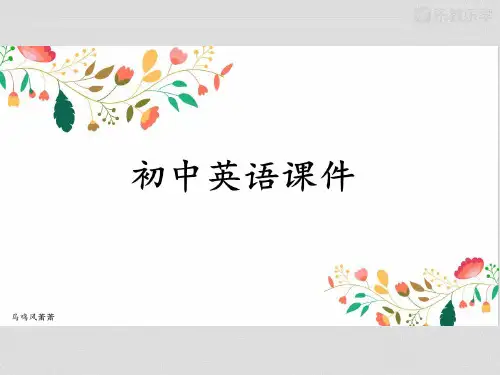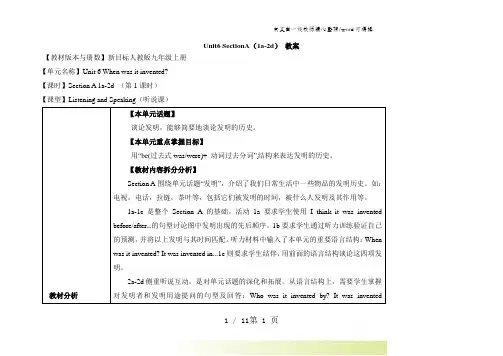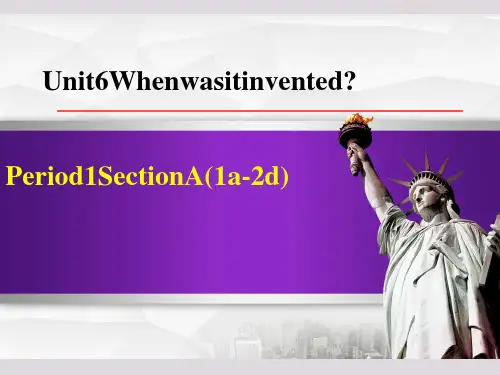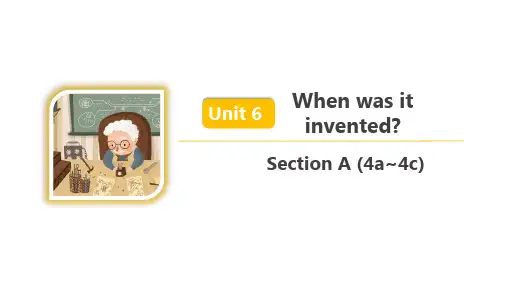人教版九年级英语上册课件Unit6SectionA第二课时
Unit6SectionA(3a-4c)课件九年级人教版英语全一册

其他常见的“It is ...that ...”句式:
It is believed that ... It is reported that ... It is known that ...
“人们认为/据信……” “据报道……” “众所周知……”
【习题演练】
( C )1.______ that thousands of people died in the earthquake.
学以致用 根据语境或提示,完成填空。 1.The girl took a fresh rose out of the basket and __s_m__el_t_/s_m__e_ll_e_d___ (闻) it. 2.Make sure to l_o_c_k__ the door when you leave home. 3.Look, how poor she looks! There seems no reason to d_o_u_b_t__ her story. 4.Mr.White was lucky to buy this TV set at such a _l_o_w__ price. 5.It is difficult to t_r_a_n_s_la_t_e___ some hot words such as neijuan, fan'ersai and wude into English.
7.__I_t __ is believed that tea was brought to Korea and Japan during the 6th and 7th centuries.In England, tea appeared around 1660.The tea trade from China to Western countries 8 . _t_o_o_k__ place in the 19th century.This helped to spread the 9._p_o_p_u_l_a_r_it_y___ of tea and the tea plant to more places around the world . 10 . _W__it_h_o_u_t___ doubt, the Chinese are the ones who best understand the nature of tea.
人教版英语课件九年级Unit-6whenwasitinvented课件SectionA4a-4c

时态 肯定形式 否定形式 疑问形式
一般 过去
S+ was/were
+done
S+ was/were +not+done
Was/Were +S+done?
时
让我们看一看各种句型的主动语态变为被 动语态时,到底发生了什么变化? Mariaboughtthebooklastyear.(主动句)
4.translatethebookintodifferentlangua ge
把书翻译成不同种类的语言 5.allofsudden突然 6.workon从事,进行
用所给词的适当形式填空。
1.Thisinstrumentisusedfor(playp)lmayuisnigcinclas s. wereborrowe
Whenwasteabroughtt ItwasbroughttoKore
oKorea?
aduringthe6thand7th
centuries.
Whatisthehotice-
It’susedforservingr
creamscoopusedfor? eallycoldice-cream.
Thepassivevoice 被动语态
—Whyistheclassroomsodirty? —Sorry,sir.It_______yesterday. Weforgottodoit. A.don’tclean B.didn’tclean C.weren’tcleanedD.wasn’tcleaned
再次阅读翻译语法句子
Whenwasthezipperinvented?
人教版英语九年级全一册教案:Unit6 SectionA(1a-2d)

Unit6 SectionA(1a-2d)教案【教材版本与册数】新目标人教版九年级上册【单元名称】Unit 6 When was it invented?【课时】Section A 1a-2d (第1课时)【课型】Listening and Speaking(听说课)教材分析【本单元话题】谈论发明,能够简要地谈论发明的历史。
【本单元重点掌握目标】用“be(过去式was/were)+ 动词过去分词”结构来表达发明的历史。
【教材内容拆分分析】Section A围绕单元话题“发明”,介绍了我们日常生活中一些物品的发明历史。
如:电视,电话,拉链,茶叶等,包括它们被发明的时间,被什么人发明及其作用等。
1a-1c是整个Section A的基础。
活动1a要求学生使用I think it was invented before/after...的句型讨论图中发明出现的先后顺序。
1b要求学生通过听力训练验证自己的预测,并将以上发明与其时间匹配。
听力材料中输入了本单元的重要语言结构:When was it invented? It was invented in...1c则要求学生结伴,用前面的语言结构谈论这四项发明。
2a-2d侧重听说互动,是对单元话题的深化和拓展。
从语言结构上,需要学生掌握对发明者和发明用途提问的句型及回答:Who was it invented by? It was invented1 / 11第 1 页by...What was/is it used for...? It was/is used for...从活动和内容上看,2a要求学生听对话谈论三项发明,并按所听顺序为其排序;2b需要学生听懂发明的用途,补全表格。
2c 要求学生结伴谈论听力中的发明用途。
2d作为示范性对话,介绍了生活中随处可见的小发明-拉链。
【通过本单元的学习学生需掌握哪些综合技能】通过本单元的学习使学生学会谈论各种发明的历史,熟练使用被动语态。
人教版九年级上册英语授课课件 Unit 6 SectionA (1a-2d)

课文呈现
4
2
温馨提示:此符号表示
1
3 “考点精讲点拨“链接
A:IthinktheTVwasinventedbeforethecar. ① 我认为电视机是在小汽车之前被发明的。 一般过去时的 B:Well, IthinktheTVwasinventedafterthecar被. 动语态 哦,我认为电视机是在小汽车之后被发明的。
课文呈现
Paul:Well,youdoseemtohaveapoint⑦... Roy:Ofcourse!IthoughtaboutitbecauseIsawawebsite lastweek. Thepioneersofdifferentinventionswerelistedthere. ⑧Forexample, itmentionedthatthezipperwasinventedbyWhitcombJudsonin 1893. ⑨Butatthattime,itwasn’tusedwidely. Paul:Really?Sowhendiditbecomepopular? Roy:Around1917.
听力材料
Alex: Hi, Carol. Wow, what are those? Carol: Hello, Alex. Oh, these are some of the interesting inventio
人教版九年级英语全册课件《Unit 6 section A(Grammer

4a Rewrite the sentences using the passive voice.
4. Our parents advised us not to go out alone. We were advised by our parents not to go out alone.
5. Different writers translated the book into different languages. The book was translated into different languages by different writers.
Iitnmveennt一etido般nbey过dWt去hhaitt时ctoh被me bz动ipJ语pued态rsownasin1893.
The bwoaosk/ wdesrec+ri及be物s动ho词w的te过a 去pl分an词ts were grown and used to make tea. It was believed that tea was brought to Korea and Japan during the 6th and 7th centuries.
比较一下主动句和被动句,这里被动句 的表现形式更好一些。
4a Rewrite the sentences using the passive voice. 1. They sold the fridge at a low price.
The fridge was sold at a low price.
2. Somebody stole my camera from my hotel room. My camera was stolen from my hotel room.
人教版英语九年级全一Unit 6 Section A (4a~4c)课件

Warming-up Presentation
Practice Production Summary
Observe and learn
Roy: With pleasure! Let me think… hmm… I know! The zipper! Paul: The zipper? Is it really such a great invention? Roy: Think about how often it’s used in our daily lives. You can see
we _r_a_n_g_ (ring) the bell. 4. The students _w__e_re__to_l_d_ (tell) not to eat or drink in class. 5. The cookies _w_e_r_e_e_a_t_e_n_ (eat) by the hungry kids in less than 20
minutes, and they really _l_ik_e_d_ (like) them.
Warming-up Presentation
Practice Production Summary
Read and rewrite
Paul wants to know some information about the jeans. Read and try to help him rewrite these sentences.
Was it used wisely around 1917?
人教版英语九年级上册Unit6SectionA1a--1c说课稿教案与反思
Unit6Whenwasitinvented?投我以桃,报之以李。
《诗经·大雅·抑》原创不容易,【关注】,不迷路!SectionA(1a-1c)说课稿一、教材分析1.教材的地位和作用我今天说课的内容是人教版新目标英语《Go for it》九年级第6单元“When was it invented?”SectionA1a--1c。
本单元涉及内容是本书当中比较重要的一部分。
被动语态结构及运用是教学中一个难点和重点,也是学生比较不容易理解的部分,因为它是建立在各种时态之上的。
另外通过对我们经常使用的发明物的历史来开阔眼界,丰富学生的阅历,使学生养成勤于思考,善于总结的好习惯。
本课时主要任务是:让学生在原有现在时和含情态动词的被动语态基础之上进一步了解过去时的被动语态并逐渐理解其他不同时态的被动语态,它是由主动语态向被动语态的过渡,更是学生掌握被动语态及其所关联的其他时态被动语态的结构及运用的关键。
另外本课所涉及的情感教育,于现实十分的有用,它通过发明物为线索讲述了中国古代四大发明,教师可因势利导,激发学生的爱国热情,培养学生对科学技术创新的浓厚兴趣,形成积极的学习态度,同时促进语言实际运用能力的提高。
二、学情分析(一)新课程标准规定,九年能级学生要完成分级目标的五级标准,即有较明确的英语学习动机和积极主动的学习态度,能听懂教师有关熟悉话题的陈述,能就日常生活的各种话题与他人交换信息。
依据目标,我应用任务型教学,采取如下教法:1.听录音听音是英语学习的重要方法,也是课堂教学的重要步骤。
在听中可以感知,可以模仿。
2.重点解释在教学中,对学生遇到的困难和模糊的地方进行解释,有效发展学生的综合语言运用能力和知识的准确性。
3.情景对话通过对话逐步达到对教材内容的全部操练。
在对话时可不受课文内容和顺序的限制,师生完全可以根据当时的实际思路创造性地交流,这种教法是实现语言知识向语言能力转变的必经之路。
人教版九年级英语全册Unit6 SectionA2d-Grammar Focus课件
Not For Jazz We have an old musical instrument. It is called a clavichord. It was made in Germany in 1681. Our clavichord is kept in the livingroom. It has belonged to our family for a long time. The instrument was bought by my grandfather many years ago. Recently it was damaged by a visitor. She tried to play jazz on it! She struck the keys too hard and two of the strings were broken. My father was shocked. Now we are not allowed to touch it. It is being repaired by a friend of my father's.
2. Somebody stole my camera from my hotel room. _M_y_c_a_m_e_r_a_w_a_s_s_t_o_le_n_f_ro_m__m__y_h_o_te_l_r_oo_m__. _
【点拨】分析原句的句子结构可知,stole是谓语动 词, my camera是句子的宾语;改为被动语态句时,应将my camera作句子主语,谓语动词用was stolen的形式。
What’s this? Zipper. n. 拉链
Where can you see it? Pants, trousers, bags, backpacks, dressers, shoes, suitcase, etc.
Unit6Period2SectionA(3a_3c)课件-人教版英语九年级全册
答案呈现
6A
习题链接
1 trade
课后巩固·拓展延伸
6 boiling 11 less than
答案呈现
2 rulers 7 smells 12 spread the popularity of
3 remained 8 popularity 13 by accident/chance
4 doubt 9 national 14 It is said that
How I wish to go!
A. sounds
B. smells
C. tastes
D. feels
【点拨】sounds听起来; smells闻起来; tastes尝起来; feels感觉。结合句意可知, “听起来” 符合语境, 故选A。
5. 【2021·温州改编】当贝蒂看到失物招领启事时, 她 怀疑这块表是不是她的。 Betty ___d_o_u_b_t_e_d__ ___if_/_w_h_e_t_h_e_r__ the watch was hers when she saw the Lost and Found notice.
一、根据句意及汉语提示完成句子 1. The two countries do little __t_r_a_d_e__(贸易) with one another. 2. Castles were lived in by ____r_u_le_r_s___(统治者) and powerful people.
B. Consumers.
C. Products.
D. QR codes.
【点拨】原句为:This provides consumers with a greater level of trust in the products they buy 这让消费者对所购 买的产品有了更大的信任,故选B。
人教版九年级英语 Unit 6 Section A(3a~3c) 精品课件
Warming-up Pre-reading While-reading Post-reading Homework
Read and match
Para. 1
1. Lu Yu and his book Cha Jing.
Para. 2
2. How tea spread to other countries.
Listen and read
Listen and read aloud.
Warming-up Pre-reading WWhhiillee--rreeaaddiinngg Post-reading Homework
Fill and retell
Shen Nong Lu Yu
Cha Jing
England the Chinese
around 1660
in the 19th century
Tea was brought to Korea and Japan.
Tea appeared in England.
The tea trade from China to Western countries took place.
Warming-up Pre-reading While-re points
1. Did you know that tea, the most popular drink in the world (after water), was invented by accident? 你知道茶这种在世界上最受欢 迎的饮品(仅次于水),是偶然被发明的吗? (1) by accident 意为“偶然地;意外地”。其同义短语为by chance。 ➢ Our meeting in Paris was by accident. (2) accident 名词,意为“事故;意外事件”;accidental 形容词, 意为“意外的;偶然的”。 ➢ He had an accident on his way to work. ➢ I don’t think our meeting was accidental.
- 1、下载文档前请自行甄别文档内容的完整性,平台不提供额外的编辑、内容补充、找答案等附加服务。
- 2、"仅部分预览"的文档,不可在线预览部分如存在完整性等问题,可反馈申请退款(可完整预览的文档不适用该条件!)。
- 3、如文档侵犯您的权益,请联系客服反馈,我们会尽快为您处理(人工客服工作时间:9:00-18:30)。
4. What is Cha Jing about? _T_h_e_b__o_o_k_d_e_s_c_r_ib_e_s_h__o_w__te_a__p_la_n_t_s_w__e_r_e_g_rown _a_n_d_u_s_e_d__to__m_a_k__e_t_e_a_. _It_a_l_s_o_d_i_s_c_u_s_se_s_w__h_ere _th_e__fi_n_e_s_t_t_ea__le_a_v_e_s__w_e_r_e_p_r_o_d_u_c_e_d__a_n_d_w__hat _k_in_d_s__o_f_w_a_t_e_r_w__e_re__u_s_e_d_. ______________
Para. 1 Lu Yu and his book Cha Jing Para. 2 How tea spread to other countries Para. 3 How tea was invented by accident
偶然;意外地
3b Read the passage again and answer the questions.
Answer the questions according to the video.
1. What is the video about? It’s about the tea culture in China.
2. Who is the writer of Cha Jing? Lu Yu.
Pre-reading
fell into …and remained…
boiling water over an open fire
tasted the brown water —tea
While-reading
3a Read the passage quickly and match each paragraph with its main idea.
2. Tea was first __d_r_u_n_k__ by Shen Nong 5,000 years ago.
invent, drink, bring, produce, trade
3. A nice smell was _p_r_o_d_u__ce_d_ when the tea leaves dropped into the hot water.
➢ Key sentences:
1.—When was tea brought to Korea? — It was brought to Korea during the 6th and 7th centuries.
➢ Learn some Reading Skills
Lead in
Let’s enjoy a video.
Who was tea invented by?
It was invented by the Chinese ruler called Shen Nong.
Shen Nong
How was it invented?
It was invented by accident. produced a nice smell
This __h_e_l_p_e_d_ (help) to spread the popularity
of tea and the tea plant to more places around the world. Even though many people now know
about tea culture, the Chinese ____ (baer)e without doubt the ones who bestu_n_d__e_r_s_ta_n__d
v. 保持不变
(produce) a nice 来自mell so he _ta_s_t_e_d_ (taste)
n. 气味
the brown water. It was quite delicious, and so, one of the world’s favorite drinks _w_a_s__in_v_e_n_t_e_d_ (invent).
4. Tea was _b_r_o_u_g_h_t_ to Korea and Japan during the 6th and 7th centuries.
5. Tea is now _tr_a_d_e_d_ between many different countries.
Language Points
3. boil v. 煮沸;烧开 e.g. Boil the potato for 20 minutes. 把土豆煮20分钟。
4. remain v. 保持不变;剩余
① 作连系动词,后跟名词、形容词、不定 式、分词等做表语。指保持某种状态。
e.g. Peter became a manager, but Mike remained a worker. 彼得成为了经理,可迈克仍是工人。
Fill in the blanks with the proper forms according to the third paragraph.
People believed that tea __w_a_s__b_ro_u__g_h_t_ (bring) to Korea and Japan during the 6th and 7th centuries. In England, tea _d_i_d_n_’_t_a_p_p_e_a_r_ (not appear) until around 1660, but in less than 100 years, it had become the national drink. The tea trade from China to Western countries __t_o_o_k_ (take) place in the 19th century.
What’s the most traditional drink in China?
Tea has a long history. Tea was first drunk nearly 5, 000 years ago.
leaves
boiling drinking water
It smells pleasant. It tastes delicious and …
Unit 6 When was it invented?
Section A (3a-4c)
学习目标
➢ Key words & phrases:
by accident, nearly, ruler, boil, remain, smell, saint, national, take place, doubt, without doubt, fridge, low, somebody, translate, lock, earthquake, sudden, all of a sudden, biscuit, cookie, instrument
ago. It _i_s_s_a_i_d (say) that a Chinese ruler _c_a_ll_e_d_
(call) Shen Nong was the first t_o_d__is_c_o_v_e_r
(discover) tea as a drink. One day Shen Nong
1. When was tea first drunk? _It__w_a_s_f_ir_s_t_d_r_u_n__k_a_b_o_u_t__5_,0_0_0__y_ea_r_s__a_g_o_.
2. How was tea invented? _I_t _w_a_s_i_n_v_e_n_t_e_d_b_y__a_c_c_id_e_n_t_.___________
② 作不及物动词,意为“剩余”。 e.g. Only a few leaves remained on the tree.
树上仅剩下几片叶子。
5. smell n. 气味 e.g. The apples give off a sweet smell. 苹果发出非常甜的味道。
毫无疑问;的确
(understand) the nature of tea.
Complete the sentences with the correct forms of the verbs in the box.
invent, drink, bring, produce, trade
1. One of the world’s favorite drinks was _i_n_v_e_n_t_e_d_ by accident.
Fill in the blanks with the proper forms according to the second paragraph.
Lu Yu, “the saint of tea”, _m__e_n_t_io_n_e_d___ (mention) Shen Nong in his book Cha Jing a few thousand years later. The book describes how tea plants _w_e_r_e__g_r_o_w_n_ and used to make tea. It also discusses where the finest tea leaves __w_e_r_e_p_r_o_d_u_c_e_d_ (produce) and what kinds of water _w__er_e__u_s_ed_ (use).
